SCAR Review: FN SCAR-16S & SCAR-17S.
(updated 04-09-2020)
SCAR-17
This is the first rifle I’ve been excited over in years. I have a lot of experience with the FAL and think it is a great rifle, but it is 60 year old technology. Surely there is some tangible improvement? So when the SCAR-17 (SCAR-H) became available in semiautomatic for civilian sales, I was very interested.
I read many reviews from reliable sources (meaning they aren’t carrying full page FN ads in their gun magazine) and the reviews were generally positive. So I sold several guns from my collection and bought one.
I have been searching for a general-purpose rifle (GPR). That is, a gun that can handle close quarter battle, as well as reasonable accuracy at 600 meters. A lot of this is in the optic selected. More on that later.
Initial Inspection
First thing I noticed was the disparity of color between the parts. Not a functional consideration, but annoying. Pictures I’ve seen of SCAR-Hs in Afghanistan had a brown upper receiver. This was bronze. The trigger mechanism housing was dark brown. The rest of the plastic a desert tan. small parts in black.
Now this is going to seem like a sin to some collectors out there, but I am not a collector. I am a shooter. And a pretty rifle is hard to really test out for fear of scratching it. So the first thing I did was to spray paint the rifle with Rustoleum Tan, with some sage, brown and green. Good for the Sonoran desert and now that the color is no longer an issue, and I’m no longer worried about scratching it, I can get down-and-dirty with it and see how she runs.
Next things I noticed was the light weight, the ease of charging, and the absolutely atrocious trigger (more on that later). I also noticed the stock latch was defective. I’m trying to be nice, but it is defective. It sits too high to latch without the first depressing it. I beveled the edges and rounded the cam surface on the stock and it is now better, but it still takes a good snap to latch open and I’m just waiting for the tabs to shear off.
Iron sights are adequate but I don’t think there is enough material around the rear peep sight aperature. It doesn’t make for a good sight picture. I will probably replace it with a different one after I confirm the heights are the same.
Disassembly is a breeze. Remove front pin (retained) in trigger mechanism housing, slide forward. Slide stock assembly down. remove spring and guide. Retract bolt carrier. Remove cocking handle to free bolt carrier for complete removal. Bolt is rotating like on the HK G36.
The trigger is atrocious. More on that later.
Depress plunger and rotate gas regulator, retract. And this is the part I’m not thrilled with. You need a cleaning rod to push gas piston forward from the rear. I’ll look into that more later. Time to shoot.
Test Firing
Since Accuracy testing was my initial interest, I put a Leupold MK IV on it. 10x scope with .308 BDC and mil-dot reticle. I also added a TANGO DOWN bipod, although this prevents the stock from folding. I’d need to move it forward one more groove on the rail and there is no space for that.
Update: VLTOR, MI, Primary Weapon Systems and FN all offer an extended rail. I’ve used both the MI and the PWS. MI includes the bottom rail, and it puts the top rail on the same level as the receiver rail The PWS has the top rail stepped down. What one wishes to mount here may affect your choice, but they are both good. Not necessary unless you plan on mounting something here – I’m using an IR laser with PVS14 night vision.
I fired 200 rounds from 25 to 330 meters. I was using Portuguese FMP 147g ball. Once I got the scope dialed in I fired 20 rounds at 100 meters. 16 of the rounds were within 1.5″. I think that is pretty impressive. I am less interested in the best three round group of the day than the extreme spread of a full mag. I used a sandbag front and a rolled up towel under the pistol grip to eliminate operator error (me!) as much as possible.
While the 10x Leupold is good for a Designated marksman scope, it lacks speed of target acquisition for multiple targets at various ranges.
I had one painful malfunction when I obstructed the reciprocating charging handle with my hand. One would think this self-correcting, but I’ve since done it twice more. Okay . . . I’m a slow learner. I moved it to the right side, like on the AK, M14, and M1 Garand.
Next I tried an ELCAN. It has a blended 5.45 & 7.62 reticle with the minimum distance 300 meters. It was fast, but I found it a little cumbersome. This is where the adjustable length stock came in useful as the ELCAN and the Leupold required different eye-relief. I was hitting 2′ diameter rocks at 300 and 500 meters, which I suppose is acceptable.
I tried an Aimpoint for rapid shooting. It worked well out to a hundred meters. Very fast. The rifle balanced well.
I cut my finger because the throw lever was on the left side and in the path of charging the weapon. So whatever side your cocking handle is on, the mounting lever/screws for optics should maybe be on the other side.
Reasonable accuracy squatting – again, the 10x was “too much” and the narrow field of view made it hard to rapidly acquire targets
Off-hand, balance again was nice.
Here is YouTube link to my daughter shooting it.
YouTube SCAR-17
SCAR-16
I liked the SCAR-17 so much, I had to try the SAR-16.
I really think the SCAR-17 is a step up from the other 7.62 offerings, but what about the SCAR-16? It’s probably not as big a step up over a quality AR-15, but in one area I think it is, and that’s shooting with a silencer.
DI ARs require some tweaking to function well with a silencer, and even piston ARs that don’t have a silencer setting can have excess backpressure. So I sold off 2 of my ARs and bought a SCAR-16. I’m pleased with it, especially from a training perspective – my light rifle and heavy rifle are functionally the same, other than caliber.
In timed drills 10 rds – 2 on 3 targets, then return to 4 on center target) I was running around 3.5 seconds with the SCAR-17 and 2.8 seconds on the SCAR-16. So it is faster. But is it enough faster to keep both calibers? I’m not quite ready to abandon 5.56 altogether, although I’m tempted. I’ll definitely get rid of my last 2 ARs and get another SCAR-16.
So a friend of mine was interested and so I lent my rifle to try out, and he had nothing but malfunctions. Awww – crap? It hadn’t occurred to me to mention it to him, since I use GI and Lancer magazines, but I should point out that PMags don’t work. The gun is designed for GI spec mags and the PMag is not. The clearance for the mag follower on the Pmag is V shaped and on the GI mag (and (Lancer) is U shaped. The PMag causes the bolt hold-open to engage all the time. It’s a quick trim on the PMag with a razor blade or Dremel tool, but be aware of this.
Trigger Work
The trigger sucks. There is no excuse on a rifle of this quality and cost to have such an atrocious trigger! Using a Lyman digital scale, the average of 10 pulls was 8-3/4 pounds. Not acceptable.
I spent considerable time working to improve the trigger and have included that information for your entertainment –
– but the short answer is to suck it up and pay $325 for the Geissele Automatics Super-Scar trigger. It’s awesome. It is relatively easy to install. You must use their grip screw, as the longer factory screw can contact the trigger.
Trigger is of AR-15 style. The surfaces were rough and showed no finish work other than the disconnector engagement. Hammer spring is typical of FAL/HK.
The selector sucks. It is easy to turn on, hard to turn off. Magpul has a replacement I installed and it was a huge improvement. Removal involves unscrewing a small threaded pin on each side. The right side must come off first, which allows the left side to be retracted slightly.
Here you can see the large R side plunger that gives the selector its “click-click”
The selector does not have to removed entirely to free the fixing plate (retains axle pins). This plate is of the same type as the FAL or FNC or the Shepherd’s plate on the AK. It slides to the rear and then rotates up for removal.
front push-pin is retained with a spring clip. Not shown – pistol grip screw is retained by a nut trapped in a slot of the trigger mechanism housing. This alleviates my concern that the screw went into plastic.
here you can see the trigger and disconnector with hammer removed. I had a hard time installing the pieces by hand, so made a 3.5mm slave pin to retain all the pieces while dropping them in. The disconnector spring is not retained like on the AR-15, it is held in only by friction.
Here you can see the relationship of the hammer, trigger, and disconnector.
All the trigger components except for the selector detent which I left in the trigger mechanism housing. This part might also benefit from an oversize coil at its base to trap the spring from falling out.
Well, I tried to be conservative and turned the gritty, creepy 8-3/4 pound trigger to a still creepy but smoother 7-1/2 # trigger. This was keeping all the same angles and engagement depths, only truing the surfaces. It still was unacceptable.
I took a gamble and cut the hammer like I do on HKs. Using the PSG-1 as a model, I reduce the width of engagement by 25% each side. Then I reduced the height of engagement from .090″ to .050″. For reference, my minimum on the FAL or HK is .022, with .025″ my goal.
It is now a pretty nice 6#, and no amount of manipulation has been able to force a hammer follow, nor did another 150 rounds of live-fire. It still isn’t where it should be, but it’s definitely better.
Summary
FN to the commercial market is poor. In their defense – they are supply our military’s Special Operations Command, and I expect support will come eventually. There was a temporary shortage of magazines, but they are now common and around $35 retail.
As for the rifle – I like it so much I sold my FALs and bought two more 17s and another 16. And since I’ve had a 20+ year love-affair with the FAL, that’s saying a lot. That’s my best endorsement.
I took it to a Suarez International Designated Marksman course, taught by John Chambers. Here are a few “aren’t we cool” pictures.
Misc Pictures
I decided to play with a different camouflage technique.
Rustoleum “army green” (sage) with Rustoleum or Krylon green brown and tan. Spray in large areas, then “digitize” the demarcations with a sea sponge – bringing the light into the dark and the dark into the light.
On subsequent attempts, I left more of the contrasting base colors and less of the digitizing, so as to maintain more contrast (disruption).
I’m still playing with accessories such as a front pistol grip and bipod. I’m also seeking the optimal optic. So far it appears the Aimpoint is best for CQB, the 3.5x ACOG for medium range (and best general purpose), and an adjustable scope of at least 8x on the high end best for long range. With the quality of the rifle as high as it is, I think the optic defines the role, where in the past it was a different rifle for each role.
Here’s a FAL I did with the greater contrast and no sage, since the end-user is not in the Sonoran Desert as I am. I think it makes for better disruption of the outline.
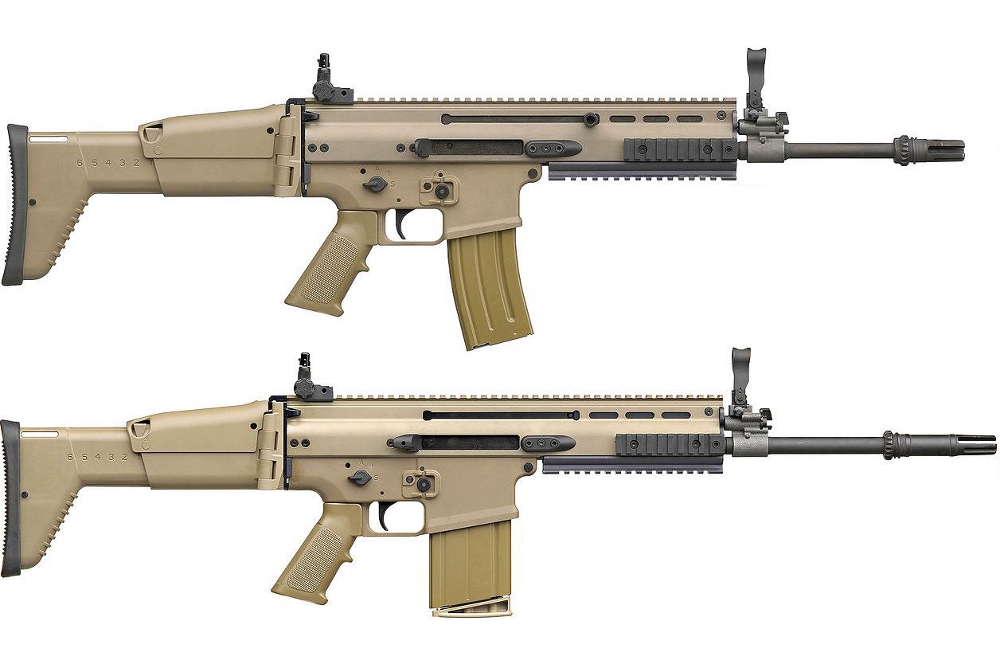



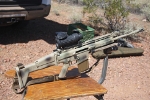
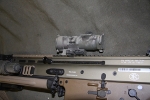
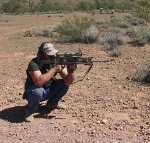
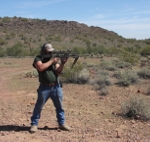






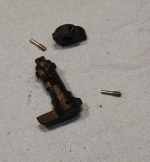
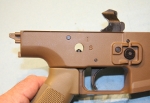

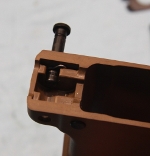
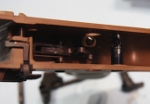
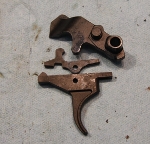


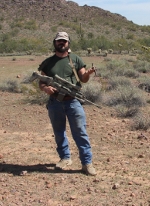








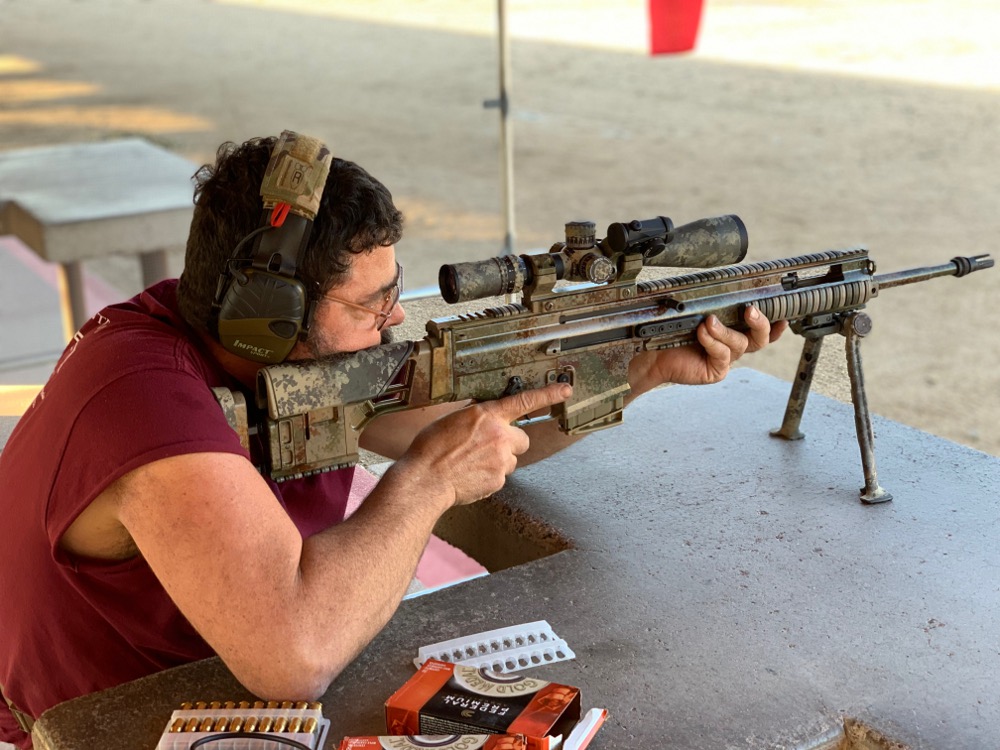
Leave a Reply
You must be logged in to post a comment.